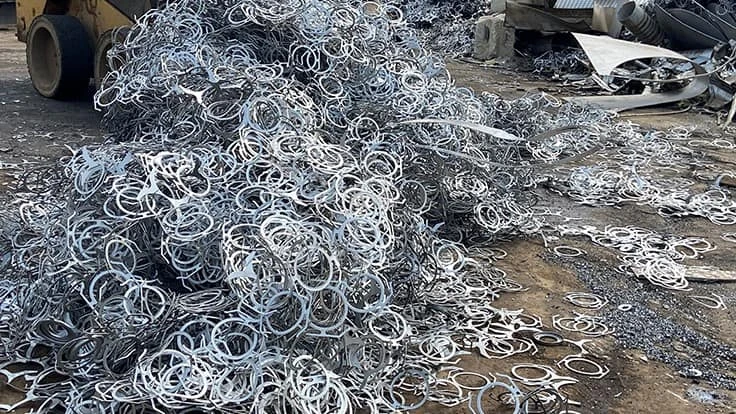
Photo by Recycling Today staff.
The Brussels-based industry association known as European Aluminium has listed a boost in aluminum recycling activity on that continent as a leading factor in progress made toward its 10-year sustainability road map goals.
According to the group, 51 percent of the aluminum being produced in Europe is now made from recycled content. It is one of three highlights spelled out by the group in a mid-term progress report on the road map, which was released in 2015 and set goals to be reached by 2025.
The group says, “At European Aluminium, we understand sustainable aluminum as aluminum that is produced with rigorous processes that respect high environmental, social and governance (ESG) standards considering all steps of the aluminum value chain, from sourcing raw materials to managing end-of-life products."
The association calls aluminum “the base metal for Europe’s transition to a climate-neutral and circular economy, helping realize the ambitions of the European Green Deal. The endless recyclability of our metal further contributes to decarbonization and the circular economy.”
Regarding decarbonization, European Aluminium includes “reducing direct emissions with breakthrough technologies” and “electricity decarbonization” as strategies joining “maximizing aluminum recycling” that can help the industry sector reach that goal.
The organization calls the 2015-2025 time frame its “decade of action,” adding “the European aluminum industry is committed to continuously evolving our sustainability objectives to deliver on our ambitions and mission.”
The goals for 2025 lead to a further ambition toward “a new aim of climate-neutrality by 2050,” writes European Aluminium. “We are poised to work with energy operators, policymakers and other stakeholders to develop an enabling legislative and funding framework that will help us reach our aim.”
As with the 2025 goals, those for its Vision 2050 plan involve recycling. “In parallel, we are developing concrete pathways for our industry to decarbonize,” states the group. “For example, by increasing the share of aluminum recycling, we can reduce 39 million metric tons of CO2 per year by 2050.”
Several initiatives and investments in aluminum recycling in Europe have been announced in the past several months. This January, a France-based firm called Nova Met has signed an agreement with a port agency in that nation to set up a 2,500-metric-tons per month secondary aluminum production site in Rogerville, France, near Le Havre.
France-based Constellium also has indicated it plans to increase its use of scrap materials in its aluminum production processes, citing supply security as an additional reason.
In Europe, primary aluminum supplies have been affected this winter by rising energy costs, which have caused some primary producers to scale back output.
Tying into the secondary melt shop investments, several scrap recycling firms in Europe have invested in systems to harvest more and cleaner aluminum scrap, including Sweden-based Stena Recycling at a plant in Denmark and Konstantinidis Bros. SA in Greece.
The two-page European Aluminium mid-term review can be found on this web page.
Get curated news on YOUR industry.
Enter your email to receive our newsletters.Latest from Recycling Today
- European project yields recycled-content ABS
- ICM to host co-located events in Shanghai
- Astera runs into NIMBY concerns in Colorado
- ReMA opposes European efforts seeking export restrictions for recyclables
- Fresh Perspective: Raj Bagaria
- Saica announces plans for second US site
- Update: Novelis produces first aluminum coil made fully from recycled end-of-life automotive scrap
- Aimplas doubles online course offerings





